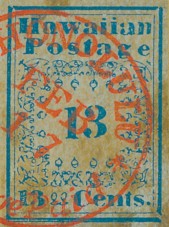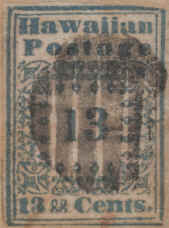|
Grinnell Missionaries |
|||||
|
A Summary of the Grinnells
I was recently asked by a knowledgeable philatelist the following question: "I am confused by all of the press in Linn's Stamp News and elsewhere about the Grinnells, are they genuine or are they forgeries?" Even a short answer to that question, however tempting, is not completely adequate. One can factually reply that the expert committee of the Royal Philatelic Society has declared them to be forgeries. In addition, they were found to be forgeries by a court of law in 1922, and the recognized experts in Hawaiian philately have uniformly opined that they are forgeries. Yet the story persists in print and in advertisements that they might be genuine. What constitutes a genuine Hawaiian Missionary stamp, or any genuine stamp for that matter? I believe that for a stamp to be considered as genuine, and issued for use to pay postage on letters, it must conform in principal characteristics to stamps found genuinely used on covers which went through the mail system. Other items prepared by a stamp-issuing entity but not found on the genuine covers may belong in one of several different classes - proof, essay, reprint, prepared but not issued, or even status unknown. There are over 25 genuine covers bearing accepted, genuine Missionary stamps. The stamps on these covers, and the other accepted genuine Missionary stamps that have been soaked off cover, have certain characteristics which define a genuine Missionary stamp. The pamphlet published by Mystic Stamp Company, The Case for the Grinnell Missionary Stamps, contains excellent illustrations of the differences between the accepted Missionary stamps and the Grinnells. These differences are substantial and clearly indicate that the Grinnell's are not from the same printing as any of the accepted genuine stamps. The initial question is: were any of these stamps used on genuine covers? The answer is no. None are known on cover, all the reported examples are from a single source and although some are tied to pieces, none survive on a full cover. If none are known on cover, can it be shown that they were used postally? This would be possible if the cancels on the Grinnells matched postmarks and cancels found on known genuine Missionary stamps and covers. In fact, they don't. The circular postmarks on the Grinnells are unknown on any genuine cover that originated in Hawaii. In fact, there are no reported postmarks on covers from Hawaii during the period between January and March 15, 1852 when the Grinnells were supposedly used. This may be due to an inadequate census of covers used during that period but it is more likely that postmark devices had yet to arrive at Honolulu. The earliest reported circular postmarks used in Honolulu are reported from March and April 1852 and do not match the postmarks found on the Grinnells. The earliest reported cancels used on cover do not show up until September 1852. In addition, certain aspects of the postmarks found on the Grinnells, including the fact that only 5 different digits were used to compose the 16 different reported dates (see article here), mimic techniques commonly used by forgers. To summarize the above, the facts are that the stamps differ significantly from the genuine and the postmarks do not match any genuine example found on cover. So, what argument for their authenticity could possibly be left? The Tale The Grinnell stamps come complete with a compelling story that purports to tie their origin to a family bible associated with someone that was living in Hawaii during the earliest period of use of the Missionary stamps. In addition, certain statements regarding the Grinnells have appeared since they were "discovered" in 1922 have proven to be inaccurate or false. These slivers of mis-information have given hope to the owners of the Grinnells and some other authors that by pursuing the matter further there might be a change in the consensus of opinion that they are forgeries. Others have suggested that until the person who printed the Grinnells is identified, the story should live on. Although the tale has taken on a life of its own, the underlying facts regarding the Grinnell stamps are not likely to change. Failing the discovery of a genuine cover with a Grinnell stamp on it, or even a genuine example of the Grinnell style postmark on a genuine stampless cover, the tale alone will never be enough to establish authenticity. Errors of fact regarding the tale need to be examined as closely as the stamps themselves. However, there is little incentive to spend the time required to disprove the tale while there is tremendous economic incentive to have them accepted as genuine. |
|||||
Richard Frajola (August 9, 2006)




